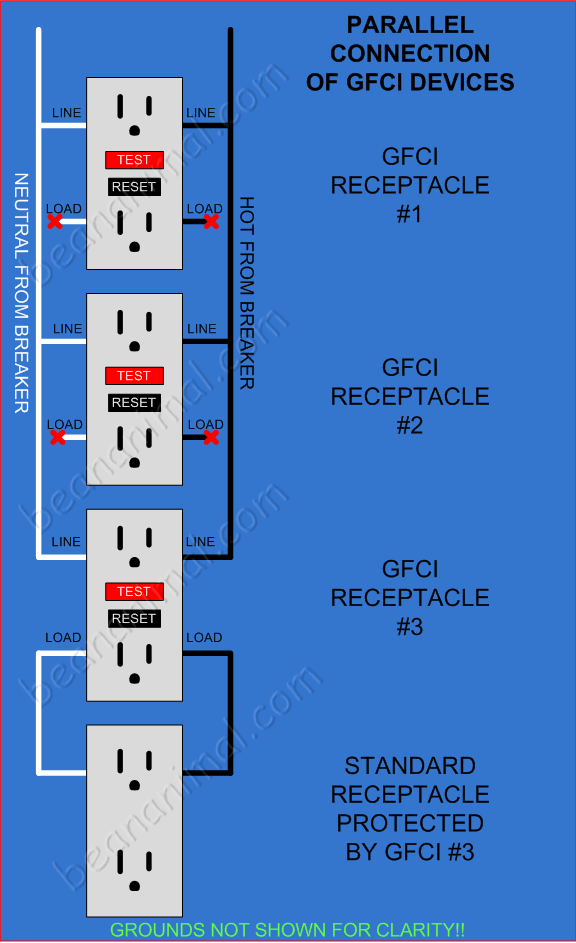Darryl_V
Super Active Member
- Joined
- Jun 29, 2011
- Location
- Woodstock, Ontario
Bird with both feet on a high voltage wire = alive
Bird with one foot on wire and one on ground = dead
Bird with one foot on wire and one on ground = dead
We're trying to keep it that way.Jewel link said:nice lively debate,
Boga link said:I want to mention that whatever we talk here and call it \"ground\" is the house ground at the electrical panel. If you put a reference electrode outside in the ground (earth), there is going to be difference (stray?) voltage between the two. This could be one reason why if the tank is grounded, we still feel tingles on our fingers.
jroovers link said:[quote author=Victoss link=topic=7695.msg79994#msg79994 date=1391723186]
NEVER run a tank with a grounding probe if you DO NOT have a GFCI. What will happen is you touch something that is hot for example a light fixture that has a cut/short with your arm and you stick your hand in the tank. Now you have a nice toasty arm or your dead if your using both hands. Breakers don't trip fast enough to protect you, breakers are only meant to protect your home. GFCIs on the other hand will trip the instant they dectect an imbalance and you may get a very little shock at worst.
This being said I would still recommend the use of a grounding probe with a GFCI because now lets say your water is in contact with a neutral conductor (ie cut in your powerhead) and you touch your hot shorted fixture again, the GFCI won't trip without a grounding probe because there is no imbalance, all the current is coming from the neutral to the hot equally but going through you.
AdamS link said:[quote author=Boga link=topic=7695.msg80069#msg80069 date=1391738753]
I want to mention that whatever we talk here and call it \"ground\" is the house ground at the electrical panel. If you put a reference electrode outside in the ground (earth), there is going to be difference (stray?) voltage between the two. This could be one reason why if the tank is grounded, we still feel tingles on our fingers.
This is the stray current from one point to the ground. If you don't have a ground probe connected, then how can be measured? So stray current in a the tank without a probe can be determined?Darryl_V link said:You can measure stray current if you take a grounding probe in the water to a meter and the other end of the meter to ground. My fluke can measure up to 10amps. Using clamps vs. probes is best when measuring current and you should know what you are doing.
Boga link said:This is the stray current from one point to the ground. If you don't have a ground probe connected, then how can be measured? So stray current in a the tank without a probe can be determined?
KBennett link said:[quote author=Boga link=topic=7695.msg80083#msg80083 date=1391741737]
This is the stray current from one point to the ground. If you don't have a ground probe connected, then how can be measured? So stray current in a the tank without a probe can be determined?
As long as your only using one hand, not touching anything else, and the rubber boots are enough of an electrical insulator than yes.Duke link said:so if your wearing rubber boots do you not get electrocuted by putting a hand in the tank because the electricity has no way to ground?
Yes. you can have more receptacles connected to one GFCI as "loads". You can have one per circuit breaker. Or more GFCI's connected in parallel, if you want separate groups of consumers.Duke link said:is it also true that a single GFI in series with other receptacles also protects those ones? so you only need 1 gfi per circuit breaker?

Yes. you can have more receptacles connected to one GFCI as "loads". You can have one per circuit breaker. Or more GFCI's connected in parallel, if you want separate groups of consumers.Boga link said:[quote author=Duke link=topic=7695.msg80106#msg80106 date=1391744946]
is it also true that a single GFI in series with other receptacles also protects those ones? so you only need 1 gfi per circuit breaker?
